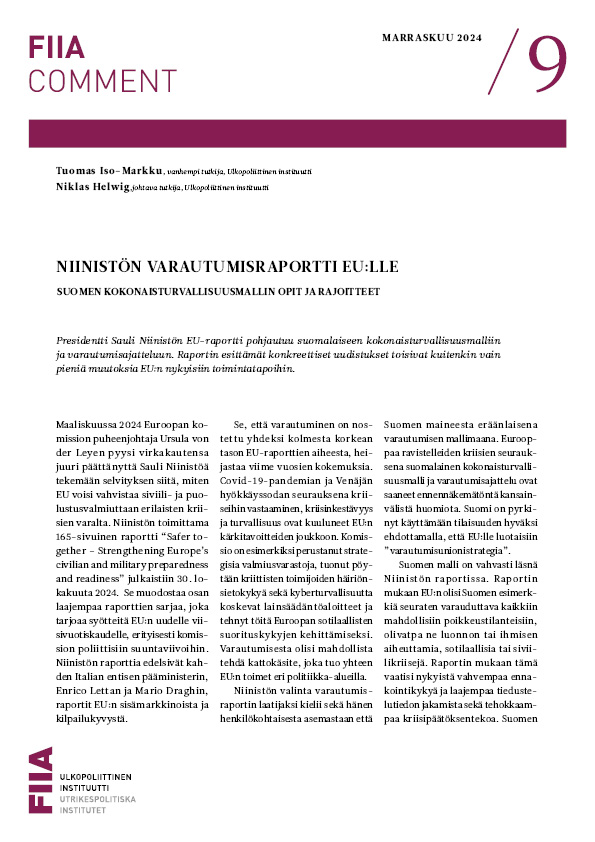Gunnar Wetterberg, Swedish historian and prominent political commentator, has for the past few years been arguing for a Nordic federation as a way of increasing the influence of Nordic states on global governance. Although the proposal remains politically unrealistic, it includes useful ideas for strengthening Nordic cooperation.
In the Nordic Council of Ministers’ and Nordic Council’s Yearbook 2010 Gunnar Wetterberg forges his proposal into the so called ‘United Nordic Federation’. It would have a common head of state, government and parliament as well as a constitution. The federation would also have a common citizenship. In addition, a Nordic currency and a central bank could be considered, if the common European currency has ceased to exist by the time the federation would be up and running in 15 to 20 years time.
Even if Nordic cooperation is still very popular among the general publics, the Nordic Prime Ministers are once again likely to reject this call for a federation in favour of the existing partnership structure—just like they did when Wetterberg’s newspaper articles were published in Dagens Nyheter. His provocative rhetoric may also lead most policy-makers to disregard his views on the future of Nordic cooperation. Nevertheless, the greatest value of this publication is not the actual proposal of uniting the five Nordic countries into a federation, but the strategic considerations that underlie it.
The catch-word ‘federation’ hides one possible solution to a topical problem. Small states’ like the Nordics are losing influence in the world of ‘Gs’, since membership of these informal groups of states is based on economic strength. The Nordic states will remain outside forums like the G20 as long as they stand alone. If they instead joined forces, they would nearly be in the top 10 of the largest economies in the world—in terms of their common GDP.
Wetterberg raises a persuasive argument for a united Nordic economic zone. Full-blown economic integration would give the Nordics a say in the G-world and bring the benefits of a larger internal market. In other words, his strategic line of thinking advocates a stronger Nordic region both internally and in the international arena. As such, this call for strengthened cooperation is worthy of a hearing in the Nordic capitals. There is a lot of hidden potential in a more deeply integrated Nordic economy and labour market with or without a federation.
This also applies to the political dimension of Wetterberg’s proposal. He suggests that foreign and security policy, including trade and immigration policy, would belong to the responsibilities of the United Nordic Federation. Economic policies would be harmonized and fiscal policies steered by the federation, while for example welfare policies would mainly remain at the national or local level of policy-making.
In the field of diplomacy or defence, burden sharing could indeed make up for diminishing national resources. The Nordics also share similar challenges stemming from ageing populations. In order to keep their expensive social security schemes running, Norden will sooner or later need to attract more workers from abroad—either together or alone.
These challenges are of course not only limited to the Nordic countries, but are largely true of the European Union as a whole. Why argue for a federation inside the EU? Wetterberg answers with clarity: he points out that Nordic integration can strengthen European integration and vice versa. The two processes are not contradictory, but complementary. According to one possible reading, he depicts Norden as a model region inside the EU. It could also be called a ‘core Europe’ or an avant-garde group of states that has the potential for deeper integration than all EU member states do together.
Here lies his strength. Wetterberg questions the wide-spread assumption that the Nordics need to choose between Nordic cooperation and European integration. In fact, the EU could have much use for a Nordic pioneer group of states that would focus on policies where they have a stakeholder interest. This ‘Nordic core’ in the EU could for example take a leading role in the implementation of the EU Baltic Sea Strategy.
All in all, Gunnar Wetterberg gives some healthy food for thought even to the most practical minded reader. He manages to prove that there is still potential in the sphere of Nordic politics, which many Nordic citizens would like to see unleashed. According to the public opinion survey published just a few days before Wetterberg’s proposal, 78 % of Nordic citizens are either positive or highly positive to Nordic cooperation in general, while 42 % of them are even supportive of a Nordic federation.








